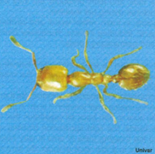Need assistance? Call 800.996.4402

Thief ants get their name from their habit of nesting very near other ants, which they then rob of food and brood (larvae and pupae). Colonies tend to be smaller than those of other species, but can contain many queens and several thousand workers. Thief ants are also known as grease ants and are often confused with pharaoh ants, although they differ in characteristics.
Mating swarms (nuptial flights) begin in late July and end in early fall.
Thief ants are attracted to greasy and high-protein foods such as nuts, breads, meats, fruits, animal fats, oils and dairy products. When outside, they will also feed on almost anything organic including insects, mealybugs, seeds, and germinating seeds.
Thief ants may carry disease-inducing organisms to human food, as they have been found feeding on dead rats and mice. They may also serve as intermediate hosts for the poultry tapeworm.
Inside, thief ants nest in small crevices, and woodwork and masonry. They commonly enter structures during hot weather in search of food and use the wires in wall voids to travel from room to room.
Outside, they nest in exposed soil or under objects, in trash, rotten wood and cavities in trees.
Nest location is critical in the prevention of thief ants; however, they are often difficult to locate. The best way to prevent a thief ant infestation is to consider working with a licensed pest professional to employ a preventative pest management plan.
For the very best food safety consulting, auditing and training, please visit our strategic partner, CFS Food Safety